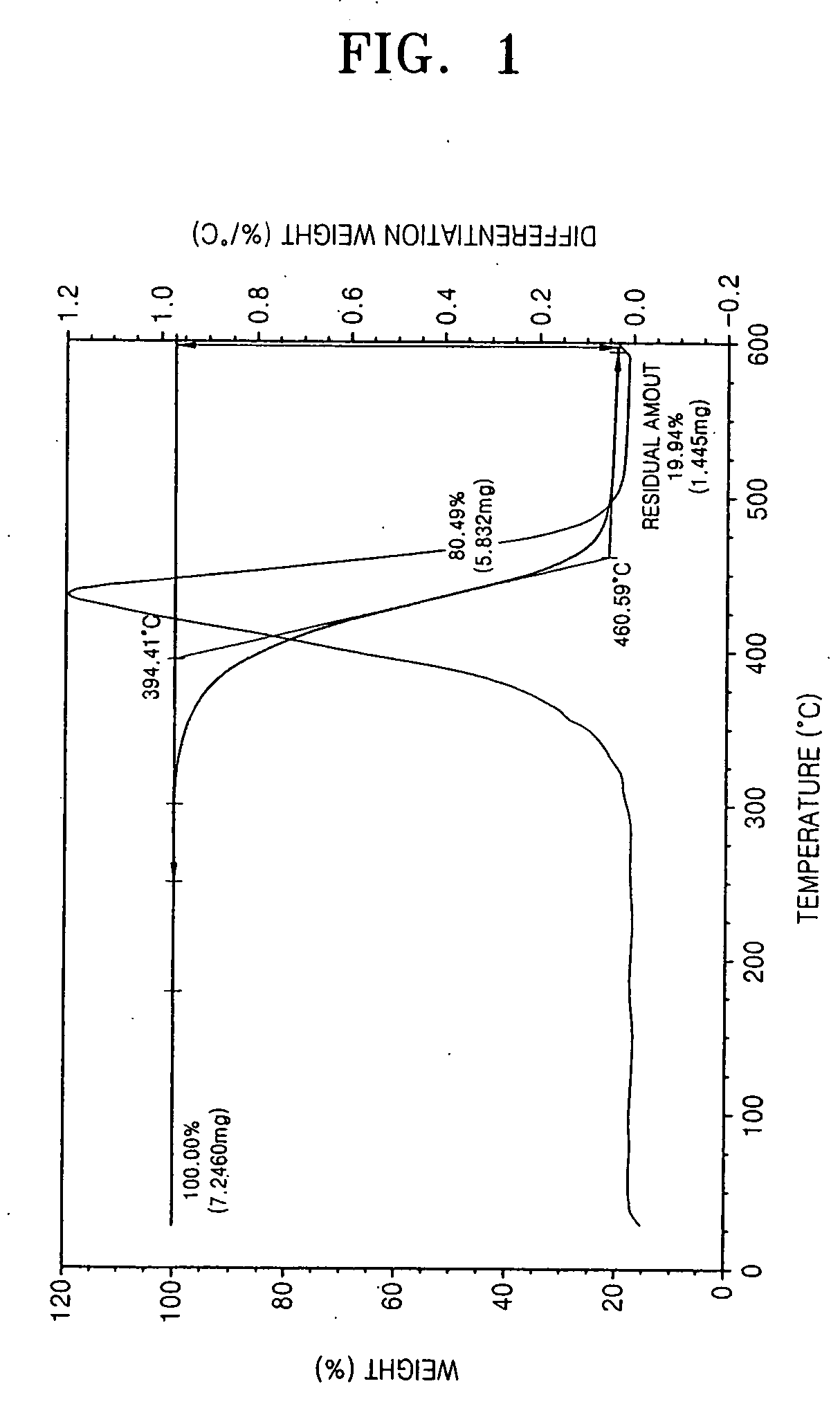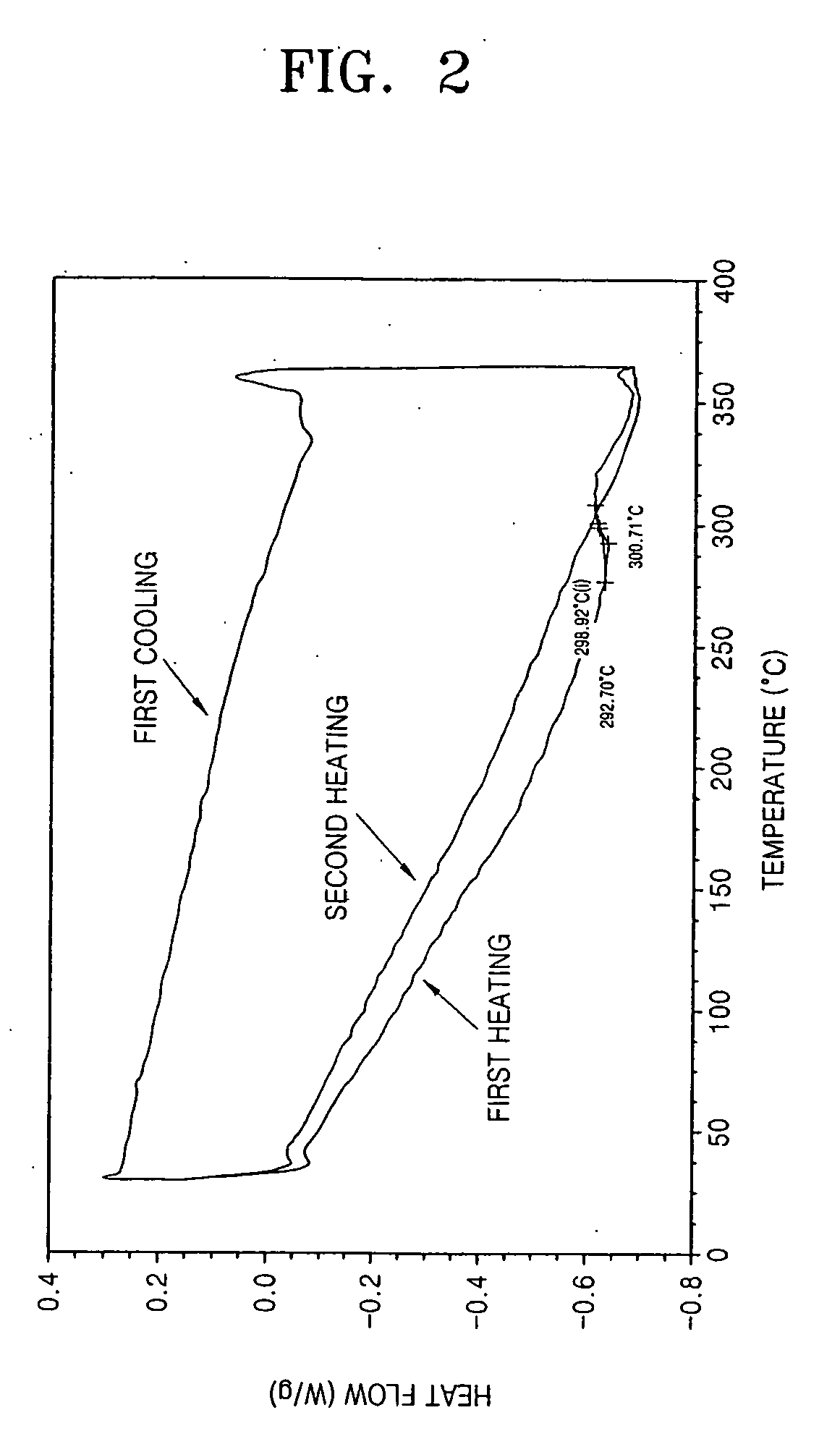Photoreactive polymer and process of making the same
a photoreactive polymer and polymer technology, applied in the field of photoreactive polymers, can solve the problems of low photoreaction rate, low thermal stability, and low photoreaction rate, and achieve the effect of improving the photoreaction rate and excellent thermal stability
- Summary
- Abstract
- Description
- Claims
- Application Information
AI Technical Summary
Benefits of technology
Problems solved by technology
Method used
Image
Examples
example 1
Synthesis of 5-norbornene-2-methanol
[0072] 397 g (3 mol) of dicyclopentadiene (DCPD) (produced from Aldrich Inc.) and 331 g (5.7 mol) of allyl alcohol (produced from Aldrich Inc.) were added to a 2 L high-pressure reactor and the temperature of the 2 L high-pressure reactor was increased to 210° C. The resulting mixture was reacted for one hour, stirring at 300 rpm. When the reaction was completed, the reactant was cooled and loaded into a distillation device. The reactant was distilled twice at a reduced pressure of 1 torr using a vacuum pump to attain a product at 56° C. (Yield: 52%).
[0073]1H-NMR (300 MHz, CDCl3): δ 6.17˜5.91 (m, 2H), 3.71˜3.19 (m, 2H), 2.91˜2.75 (m, 2H), 2.38 (m, 1H), 1.83 (m, 1H), 1.60˜1.12 (m, 2H), 0.52 (m, 1H)
example 2
Synthesis of 5-norbornene-2-methylcinnamate
[0074] 15 g (0.121 mol) of the 5-norbornene-2-methanol prepared in Example 1, 61.2 g (0.605 mol) of triethylamine (produced from Aldrich Inc.), and 20 ml of THF were loaded into a 250 ml 2-neck flask and then stirred at 0° C. in an ice-water bath. 22.1 g (0.133 mol) of cinamoil chloride dissolved in 60 ml of THF was slowly added to the prepared mixture using an additional flask for 10 minutes. Then, the temperature of the reactant was increased to room temperature and then stirred for one hour. The resulting solution was diluted using an ethyl acetate. The diluted solution was loaded into a separatory funnel, washed using water and NaHCO3 several times, and then distilled in at a reduced pressure to remove a solvent. The result was refined using a column chromatography (Hexane:Ethyl acetate=20:1) to attain a product. (Yield: 88%)
[0075]1H-NMR (300 MHz, CDCl3): δ 7.71˜7.66 (dd, 1H), 7.53˜7.36 (m, 5H), 6.49˜6.42 (dd, 1H), 6.17˜5.98 (m, 2H), ...
example 3
Polymerization of 5-norbornene-2-methylcinnamate
[0076] 5 g (19.66 mmol) of 5-norbornene-2-methylcinnamate as a monomer and 5 ml of toluene refined using a solvent were loaded into a 250 ml schlenk Schlenk flask. 0.88 mg of (CH3CO2)2Pd and 1.1 mg of tricyclohexylphosphine dissolved in 1 ml of dichloromethane, and 6.3 mg of dimethylanilinium tetrakiss(pentafluorophenyl)borate were loaded into the flask and reacted by stirring for at 40° C. for 18 hours.
[0077] Then, the reactant was added to an excess amount of ethanol so that a white polymer precipitated. The precipitates were filtered using a glass funnel and the polymer collected. The polymer was dried in a vacuum oven at 65° C. for 24 hours. As a result, 1.6 g of a norbornene methylcinnamate polymer was attained (Mw=703,000, PDI=2.0, and Yield=32%).
PUM
| Property | Measurement | Unit |
|---|---|---|
| temperature | aaaaa | aaaaa |
| glass transition temperature | aaaaa | aaaaa |
| temperature | aaaaa | aaaaa |
Abstract
Description
Claims
Application Information
 Login to View More
Login to View More - R&D
- Intellectual Property
- Life Sciences
- Materials
- Tech Scout
- Unparalleled Data Quality
- Higher Quality Content
- 60% Fewer Hallucinations
Browse by: Latest US Patents, China's latest patents, Technical Efficacy Thesaurus, Application Domain, Technology Topic, Popular Technical Reports.
© 2025 PatSnap. All rights reserved.Legal|Privacy policy|Modern Slavery Act Transparency Statement|Sitemap|About US| Contact US: help@patsnap.com



